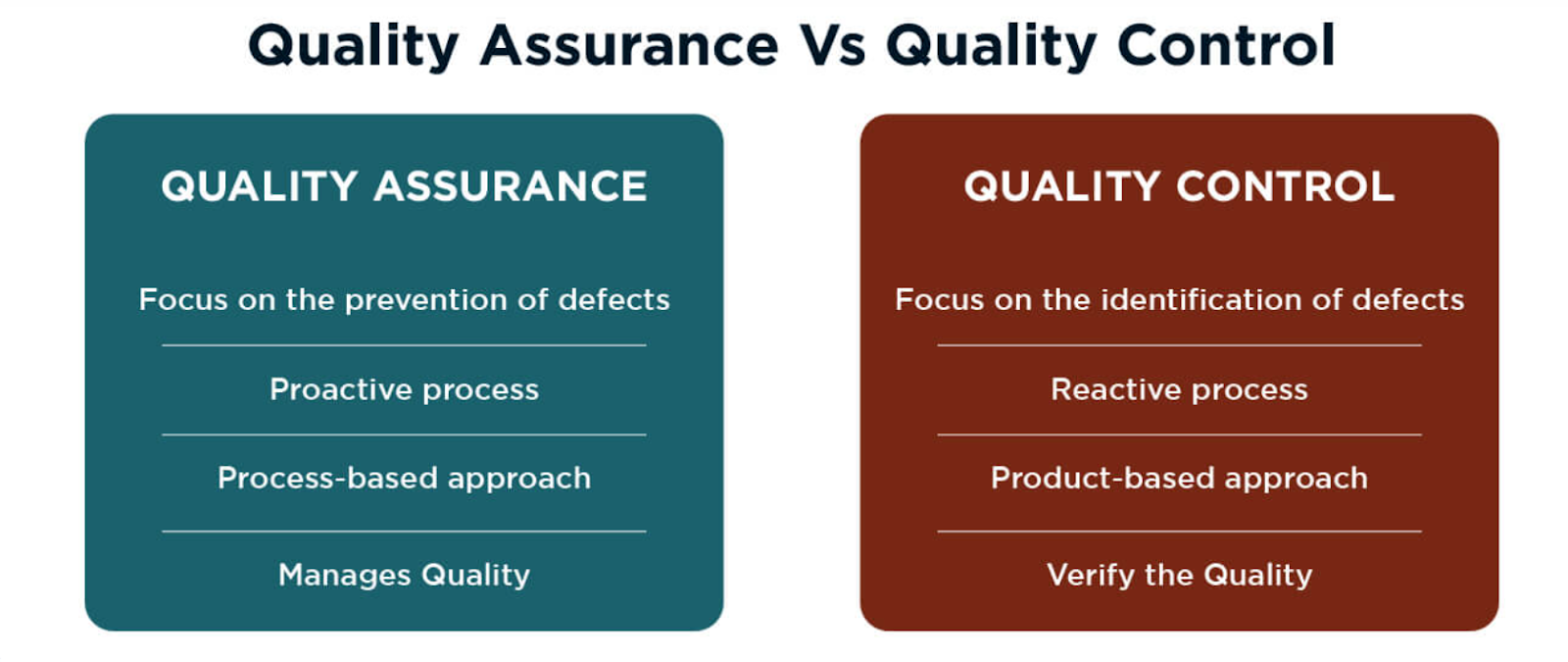In the world of manufacturing, the concepts of quality control and quality assurance are often used interchangeably. However, these two elements play distinct roles in ensuring product reliability and value. Though they work together to deliver a high-quality product, their processes, approaches, and responsibilities differ. This blog aims to delve deep into the crucial differences between quality control and quality assurance, providing a comprehensive understanding of each.
The Fundamentals of Quality Control
Quality Control, often abbreviated as QC, is a critical component in the manufacturing sphere that focuses specifically on the final product. Its fundamental role is to ensure that the goods produced align with the pre-set quality standards before they reach the end consumer. The QC process is brimming with tasks such as rigorous inspections, detailed examinations, thorough testing, and precise measurements, all directed towards validating the quality of the final product.
The primary objective of quality control is to spot and address any defects or flaws after the manufacturing process has taken place, but crucially before the product is made available to the marketplace. QC serves as the last line of defense, ensuring that any product that falls short of the standard is promptly corrected. This can entail everything from minor adjustments to the rejection of entire product batches.
In the heart of QC lies a corrective strategy that is designed to identify issues post occurrence. It reacts to errors or faults after they have surfaced, thereby enabling the team to take the necessary corrective action. This reactive and remedial approach, although coming after the production phase, plays a crucial role in maintaining the product’s integrity and meeting consumer expectations. In the next section, we will explore its counterpart – Quality Assurance, and how it complements Quality Control in an all-encompassing quality management system.
Unraveling Quality Assurance
Let’s shift our lens towards Quality Assurance (QA), a forward-thinking approach aimed at nipping defects in the bud. Rooted in prevention rather than correction, QA operates by controlling the production process in its entirety, effectively ensuring that problems are stopped in their tracks before they ever occur.
As an integral part of the manufacturing process, Quality Assurance serves as a systematic set of activities that gives adequate confidence that a product or service will meet the established quality criteria. But how does it achieve this? It’s all about meticulous management, planning, and coordination of the production process.
QA’s strategy rests on implementing robust standards and stringent guidelines that are designed to ward off any potential errors, right from the start. It encapsulates the concept of ‘doing it right the first time,’ mitigating the need for rework or adjustments later on.
What’s more, the Quality Assurance approach goes beyond merely focusing on the final product. It encompasses every process, from the inception of product design to its final delivery. Every stage in the production cycle is scrupulously monitored to ensure adherence to the quality standards.
Differences in Approach: Preventive vs Corrective
Quality Assurance and Quality Control, while being two sides of the same coin, adopt distinctly different strategies towards achieving quality. The primary distinguishing factor lies in their approaches – preventive and corrective.
Quality Assurance, the preventive approach, functions on the idea of averting defects before they occur. It is the knight in shining armor, proactively safeguarding the production process from the possibility of errors. This is achieved by implementing stringent standards and procedural guidelines right at the start of the process, establishing a shield against potential flaws.
On the other end of the spectrum is Quality Control. It employs a corrective approach that comes into play once the manufacturing process is completed. Unlike QA’s preventive role, QC steps in after an error has materialized. It is the vigilant watchman, on the lookout for defects in the finished products. Its central role is to detect errors that have slipped past the manufacturing process and take corrective measures.
In essence, Quality Assurance strives to ensure that the processes are designed in a manner that prevents errors, thus embodying a proactive approach. Quality Control, conversely, aims to identify and rectify any defects in the final product, symbolizing a reactive approach. Though different in their strategies, both QA and QC are critical for managing product quality and ultimately work in unison towards a shared goal – delivering a high-quality product. The next segment will dive into how these distinct approaches manifest in their varying responsibilities.
Varying Responsibilities: Process vs Product
As we further delve into the differences between Quality Assurance and Quality Control, the focus area of each is crucial to understand. Quality Assurance concentrates on the enhancement of the production process, operating under the premise that a refined process leads to a refined product. The responsibilities of the QA team are primarily focused on system development, creating detailed process documentation, and setting rigorous standards. The goal here is to make the process foolproof, reducing the chance of errors creeping in.
Contrastingly, Quality Control zeros in on the finished product. The process-oriented approach of QA gives way to a product-focused strategy. The factory audit in China embarks on an expedition to find and fix defects in the finished goods. The primary tools they employ include meticulous inspections, comprehensive tests, and precise measurements of the end products. The purpose of all these activities is to ensure that the finished products align perfectly with the established quality standards.
In essence, while QA crafts the blueprint for a flawless manufacturing process, QC executes a detailed examination of the end product to ensure it matches up to these standards. Both Quality Assurance and Quality Control serve unique yet interconnected roles in the vast landscape of quality management, each contributing to the goal of delivering a product that ticks all the boxes of quality and reliability.
Role in the Organization: Management vs Operational
Delving deeper into the structural differences between Quality Assurance and Quality Control within an organization, we find that their roles are just as distinct as their focus areas. QA, with its preventive and process-oriented approach, operates at the management level of the organizational structure. It is here that the strategic planning, the designing of meticulous standards, and the holistic oversight of the entire production process occur. The QA team sets the stage, ensuring that every step of the process adheres to the predefined quality benchmarks, thereby preventing potential errors before they have the chance to materialize.
Conversely, QC occupies a more hands-on position at the operational level of the organization. The QC team functions as the gatekeepers of product quality, directly interacting with the finished goods. They conduct detailed inspections, run comprehensive tests, and take precise measurements to identify and rectify any discrepancies in the final product. These rectifications could range from minor tweaks to the complete rejection of entire product batches. Essentially, the QC team is the final quality checkpoint, tasked with the significant responsibility of ensuring that no sub-standard product makes it to the marketplace.
Therefore, within the organizational structure, QA and QC are set at different levels but work in sync. While Quality Assurance lays the strategic groundwork at the management level, Quality Control applies the finishing touches at the operational level. This collaborative effort between the two is what guarantees the delivery of high-quality, reliable products to the consumer.
Summing Up Quality Control vs Quality Assurance
As we bring our deep dive into quality control and quality assurance to a close, it’s essential to remember the distinguishing traits of each. Quality Control in Vietnam, with its product-centered outlook, operates as the final checkpoint, vigilantly scrutinizing the end product for any discrepancies. It is the guardian of the finished goods, tasked with identifying and rectifying any defects before the products hit the marketplace.
On the contrary, Quality Assurance takes a broader view, focusing on the entirety of the production process. Its preventative approach, centered around proactive error prevention and adherence to stringent standards, works to ensure that quality is ingrained in every step of production. It underlines the principle of ‘doing it right the first time,’ thus eliminating the need for extensive corrections later on.
Though differing in their methods and focus areas, QC and QA aren’t opposing forces but complementary elements of a well-rounded quality management system. While QC ensures the end product meets the required quality standards, QA guarantees that the processes used to get there are robust and efficient. Together, they form a solid framework that ensures the production and delivery of high-quality products, instilling confidence in both the manufacturer and the consumer. So, remember, it’s not about QC versus QA, but rather QC and QA, working harmoniously in unison for optimal product quality.



